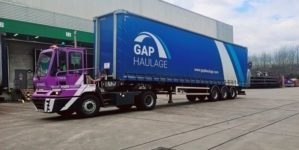-
Nutrivend selects Forterro’s Orderwise to support online expansion and streamline operations - April 11, 2025
-
ARROWXL LAUNCHES AMBITIOUS ZERO WASTE ROADMAP - April 8, 2025
-
THE BCMPA’S NEW CAMPAIGN DRIVES OUTSOURCING SUCCESS IN Q1 - April 7, 2025
-
BLACKOUT TECHNOLOGIES TARGETS TELEMATICS-INTEGRATED MOBILE DEVICE BLOCKING TO COMBAT SMARTPHONE DISTRACTION - April 1, 2025
-
OpenADR Alliance announces first OpenADR 3.0 certified products with EVoke Systems, E.ON Energy and Universal Devices - March 25, 2025
-
Growing fulfilment and contract packer appoints new Managing Director - March 25, 2025
-
When is it time to invest in a WMS? Understanding the key trigger points - March 25, 2025
-
eCapital helps Vantage Recruitment on its journey to financial success - March 24, 2025
-
Hugo Beck Celebrates 70 Years of Packaging Innovation with Open House Events - March 20, 2025
-
PROLOG FULFILMENT SUPPORTS LUNA DAILY’S COMMITMENT TO BETTER BODY CARE FOR ALL WOMEN - March 19, 2025
Three critical steps to a hi-tech, agile supply chain
By Sid Holian
Retailers are facing a new reality and as a consequence supply chains must change.
Consumers are becoming ever-more demanding, wanting their purchases faster, delivered as and when they choose and at highly competitive prices; while their smartphones are empowering them to review products, check prices and shop around on the move. Technology has enabled consumers to be highly agile in the way they shop and seek value, so likewise, retailers too must learn to leverage technology fully if they are to become agile organisations capable of delivering the services and value consumers now expect.
Here are three key points to consider when using technology to support agility:
1. Shaping the future: Understanding future demand is notoriously difficult. However, Artificial Intelligence (AI) and Machine Learning are opening up exciting new possibilities for the forecasting of demand. This burgeoning technology is being used to analyse internal data on past sales in stores, taking into account the influence of markdown value on sales volume per outlet, and this data is being aggregated across whole store geographies to help position stock more advantageously, to maximise margin.
AI is also helping to reveal predictable ordering patterns for store and online sales by bringing together external data too, such as trends on social media, economic data, the weather, and a whole multitude of other factors. All this information is analysed to help shape the expected sales quantities for each product. Big Data is used to reveal hidden patterns that are simply not visible at the item level. So, retail businesses need to tap into these fast-developing technologies to better understand and predict order profiles, as having a clearer idea of the future helps determine just how agile an organisation is needed.
2. Visibility and responsiveness: Of course, a prerequisite for achieving supply chain agility is to have complete visibility throughout the chain, and critically, that depends upon having highly connected and intelligent IT. Visibility of inventory deployment, order management and execution, right through to the customer – as well as on returns – forms the basis for automating processes and making informed decisions. This is where having agility really counts and where it can offer huge rewards.
For example, knowing where inventory is in transit allows for products to be re-directed to where demand is greatest or where the greatest margin can be achieved. Or perhaps, a home delivery may be dynamically re-routed for pick-up from a store or a click & collect locker. But enabling these actions to be taken often involves a complex set of tasks – requiring knowledge of transport routes available, possible added value services, such as re-labelling or re-packaging, and all this takes precise timing. Orchestrating tasks of this level of complexity demands highly connected, integrated systems capable of responding with speed and agility.
These capabilities, and much more, are now increasingly available through a plethora of Software-as-a-Service offerings, presenting new opportunities for creating agile retail businesses. However, there are many choices here too and SaaS may not always be appropriate.
3. Enhancing operational performance:
There are a growing number of operational challenges. With mounting cost pressures, rising demand, special promotions, multiple service offerings and the increasing scarcity of labour resources, many businesses are now looking to the automation of key processes within the warehouse and wider supply chain as a solution. Technology offers the potential to improve productivity, whether that is by using mechanisation, robotics, new SaaS offerings or advanced AI.
However, there are many important questions that need to be asked before any such investments are made. What level of flexibility is necessary in the fulfilment process and where is it most required? Flexibility tends to come at a cost, so understanding just what needs to be flexible and what doesn’t is important to determine. In a dynamic environment, such as an omni-channel warehouse, the many varied processes and physical layout of a facility should be constantly reviewed and adjusted to optimise performance. So, careful planning and analysis are essential.
A new eBook “The technology and infrastructure needed for an agile landscape” explores the various options and technologies available to those retail businesses seeking to develop an agile enterprise. Technology is the great enabler that drives productivity, but exactly which technology and where, when and how it is deployed is absolutely critical to both a successful implementation and the future performance of the business. Get it right and great gains can be made. Used imaginatively and a huge competitive advantage can be won.
To gain further insights and a greater understanding of how to use technology to create an agile and responsive supply chain, download the free eBook at: https://www.bis-henderson.com/ebook-3-launch/
Sid Holian is Managing Director of Bis Henderson Consulting

































